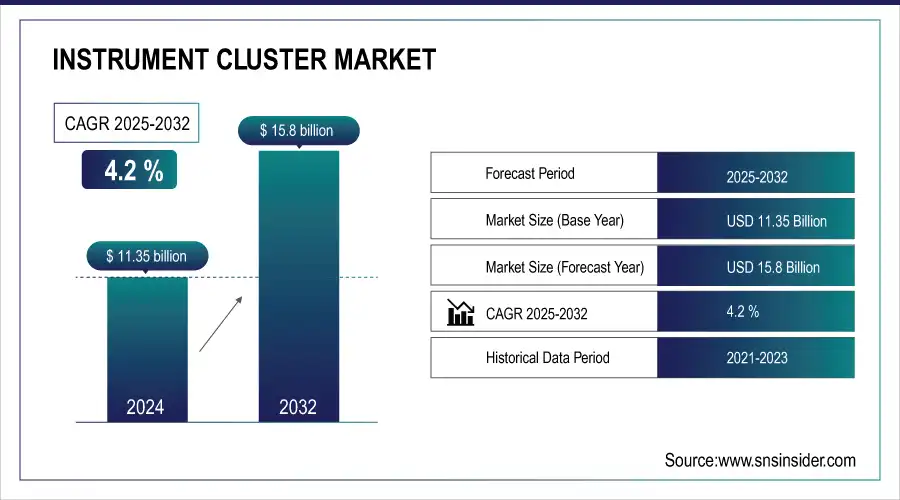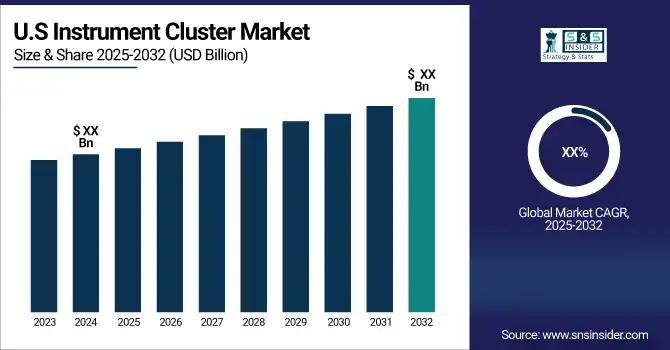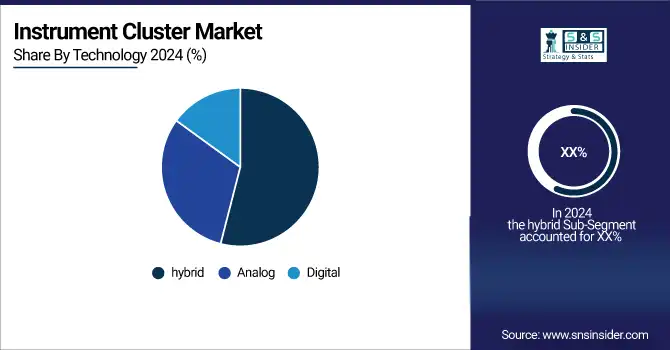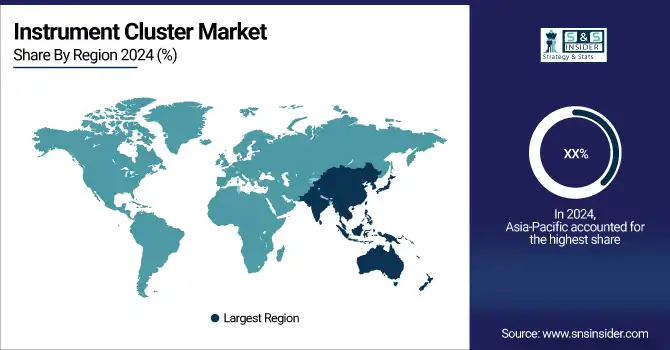Instrument Cluster Market Size & Growth:
The Instrument Cluster Market size was valued at USD 11.35 billion in 2024 and is expected to grow to USD 15.8 billion by 2032 and grow at a CAGR Of 4.2 % over the forecast period of 2025-2032. The instrument cluster is positioned immediately in front of the steering wheel, putting all of the instruments in the driver's natural line of sight. Many early automobiles have coolant temperature gauges built straight into the radiator caps, many have turn signal lights positioned at the front and top end of each fender, and some have tachometers mounted on the bonnet. When the earliest automobiles left the sheds and bars where they were constructed (or even when the first mass-produced cars were on sale), they didn't have instrument clusters. They possessed no instruments at all. Instead of resembling modern automobiles, these early vehicles were more like the carriages of the day.

Get more information on Instrument Cluster Market - Request Sample Report
Key Instrument Cluster Market Trends
-
Rising adoption of digital instrument clusters driven by increasing electric vehicle sales.
-
Enhanced visual displays providing real-time EV data such as charging time and battery status.
-
Growing popularity of advanced graphical systems for improved dashboard clarity and user experience.
-
Hybrid clusters expected to retain significant market share by combining analog and digital formats.
-
Digital clusters projected to dominate long term, supported by advances in LCD and LED resolution and size.

Instrument Cluster Market Growth Drivers:
-
Increasing inclination toward digital solutions.
-
Demand for digital instrument clusters will increase due to the rapid growth of premium electric vehicles.
The market for digital instrument clusters is anticipated to increase quickly along with the sales of electric cars. For a better user experience, manufacturers are implementing improved visual displays in digital instrument clusters. These displays, for instance, continuously display information such as the time till the next charge, the number of charged batteries, and other crucial data. Advanced visual digital systems are becoming more popular on the market as part of the evolution. The dashboard and display appearance are both improved by the graphic display, which makes things clearer and easier to see. The need for digital systems is expected to rise as automotive LCDs and LEDs' resolution and size improve to accommodate growing demand.
Instrument Cluster Market Restraints:
-
Costly digital clusters will impede market expansion
The significant barrier impeding this market's expansion is the high price of digital technology. High display, integrated circuit, and maintenance costs might stifle market expansion. Another issue that is slowing the expansion of the business globally is the growing risk of cyberattacks on digital devices in cars.
Instrument Cluster Market Opportunities:
-
Significant Growth in the Hybrid Segment is Anticipated During the Forecast Period
The market has been divided into analog clusters, hybrid clusters, and digital clusters based on cluster type. During the projected period, it is expected that the hybrid segment would hold a majority of the digital instrument cluster market share. The hybrid system combines an analog and digital display to provide data like speed, fuel efficiency, mileage, and temperature in both formats. The digital display system consists of an LCD screen that shows all the information, such as temperature, distance traveled, traffic statistics, and other warning indications, as opposed to the analog system, which consists of a speedometer and an odometer. According to predictions, the digital system will rule the market throughout this time.
Instrument Cluster Market Segment Analysis:
By Vehicle Type
In 2024, passenger cars dominated the instrument cluster market due to high demand for advanced display technologies and widespread adoption in premium and mid-segment vehicles. However, two-wheelers are projected to record the fastest CAGR from 2025 to 2032, driven by rapid adoption of digital TFT displays in Asia-Pacific markets, particularly India and Southeast Asia, enhancing rider experience.
By Technology
In 2024, hybrid clusters dominated the instrument cluster market, benefiting from their ability to combine analog reliability with digital convenience during the industry’s transition phase. From 2025 to 2032, digital clusters are expected to witness the fastest CAGR, driven by rising demand for full-digital TFT and reconfigurable displays that enhance user experience, connectivity, and real-time vehicle information delivery.

By Application
In 2024, the speedometer dominated the instrument cluster market as a primary and essential application for vehicle performance monitoring. From 2025 to 2032, the “Others” segment, including temperature gauge, fuel gauge, and oil pressure gauge, is expected to register the fastest CAGR, supported by expanded sensor integration, advanced display functions, and EV-specific indicators enhancing overall vehicle intelligence.
Instrument Cluster Market Regional Analysis:
Asia Pacific Instrument Cluster Market Insights
Asia-Pacific now holds the largest market share and is anticipated to continue to rule the industry over the coming years. Some of the key nations driving the market expansion in this area are Japan, China, and India. Government programs for the automobile sector in some emerging nations, like China and India, are eventually fostering the expansion of the market in the Asia-Pacific area.

Need any customization research on Instrument Cluster Market - Enquiry Now
North America Instrument Cluster Market Insights
The North America instrument cluster market is growing, driven by rising demand for advanced vehicles, integration of digital displays, and increasing adoption of connected car technologies. Automakers are investing heavily in high-resolution TFT and HUD-based clusters to enhance safety and driver experience. Strong presence of leading automotive manufacturers, consumer preference for premium vehicles, and regulatory emphasis on vehicle safety further fuel market expansion across the region.
Europe Instrument Cluster Market Insights
The Europe instrument cluster market is witnessing significant growth, supported by stringent safety regulations, rising adoption of electric vehicles, and technological advancements in automotive displays. Germany, France, and the U.K. lead the market with strong automotive manufacturing bases. Increasing demand for digital and hybrid clusters, coupled with premium car adoption and consumer preference for enhanced driver experience, continues to propel regional market growth during the forecast period.
Latin America (LATAM) and Middle East & Africa (MEA) Instrument Cluster Market Insights
The LATAM and MEA instrument cluster market is expanding moderately, fueled by rising automotive production, urbanization, and demand for affordable vehicles. Growth is supported by gradual adoption of digital clusters in mid-range and premium vehicles. While economic challenges and limited technological infrastructure pose restraints, countries like Brazil, South Africa, and the UAE are increasingly integrating advanced display technologies to improve driver safety, visibility, and overall in-vehicle experience.
Key Instrument Cluster Companies are:
-
DENSO
-
Visteon
-
Nippon Seiki
-
Magneti Marelli
-
Aptiv
-
Calsonic Kansei
-
Robert Bosch
-
Yazaki
-
Panasonic Automotive Systems
-
Delphi Technologies
-
Alpine Electronics
-
Luxoft
-
Simco Ltd.
-
Stoneridge Inc.
-
JP Minda Group
-
ID4Motion
-
Continental Automotive Systems
-
Actia Group
Competitive Landscape for Instrument Cluster Market:
Continental AG, a German technology company, is a global leader in automotive solutions, specializing in safety, mobility, and sustainability. In the instrument cluster market, it delivers advanced digital, hybrid, and customizable display systems, enhancing vehicle intelligence, user experience, and connected driving.
-
In January 2025, Continental unveiled its Emotional Cockpit concept at CES, featuring an E Ink Prism display that spans the dashboard. This innovate solution integrates multiple display technologies into a customizable, visually appealing interface that enhances driver interaction and interior aesthetics
| Report Attributes | Details |
|---|---|
| Market Size in 2024 | USD 11.35 Billion |
| Market Size by 2032 | USD 15.8 Billion |
| CAGR | CAGR of 4.2% From 2025 to 2032 |
| Base Year | 2024 |
| Forecast Period | 2025-2032 |
| Historical Data | 2021-2023 |
| Report Scope & Coverage | Market Size, Segments Analysis, Competitive Landscape, Regional Analysis, DROC & SWOT Analysis, Forecast Outlook |
| Key Segments | • By Vehicle Type (Passenger Car, Commercial, Two-wheeler, Agriculture, Ofthighway) • By Technology (Analog, Hybrid, Digital) • By Application (Speedometer, Odometer, Tachometer, Others (Temperature Gauge, Fuel Gauge, Oil Pressure Gauge)) |
| Regional Analysis/Coverage | North America (US, Canada, Mexico), Europe (Germany, France, UK, Italy, Spain, Poland, Turkey, Rest of Europe), Asia Pacific (China, India, Japan, South Korea, Singapore, Australia, Taiwan, Rest of Asia Pacific), Middle East & Africa (UAE, Saudi Arabia, Qatar, South Africa, Rest of Middle East & Africa), Latin America (Brazil, Argentina, Rest of Latin America) |
| Company Profiles | Continental, DENSO, Visteon, Nippon Seiki, Magneti Marelli, Aptiv, Calsonic Kansei, Pricol, Robert Bosch, Yazaki, Panasonic Automotive Systems, Delphi Technologies, Alpine Electronics, Luxoft, Simco Ltd., Stoneridge Inc., JP Minda Group, ID4Motion, Continental Automotive Systems, and Actia Group. |

